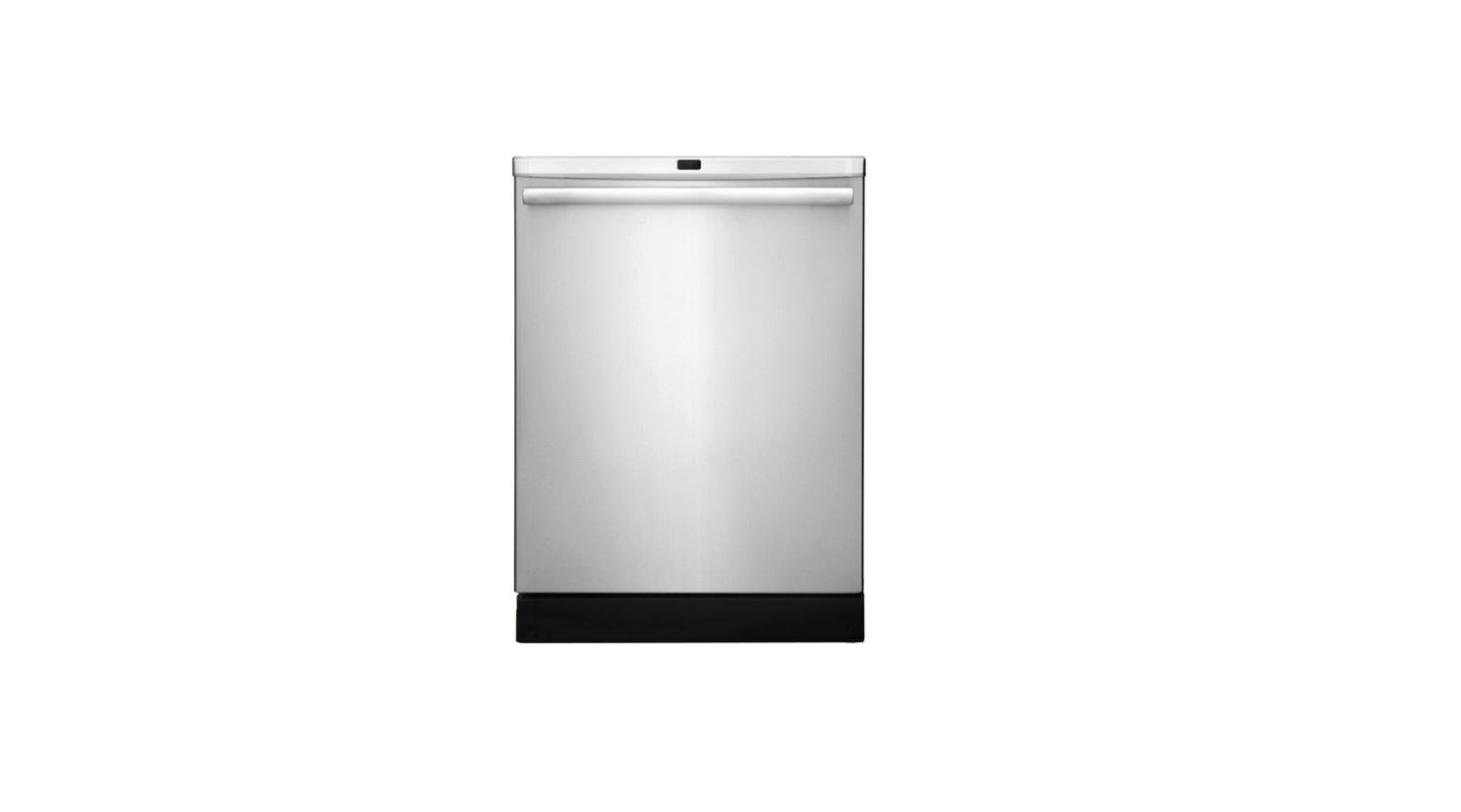![]()
Frigidaire DW3300D Dishwasher
About Frigidaire
Frigidaire is a brand of home appliances that are owned by the Electrolux Group. It was founded in the United States in 1918 and is now a global brand, offering a wide range of products including refrigerators, freezers, air conditioners, dishwashers, ranges, cooktops, wall ovens, washers and dryers, and more.
Frigidaire is known for its commitment to quality, innovation, and design, and offers products in a range of styles and price points to meet the needs of different consumers. If you’re in the market for a new appliance, Frigidaire is a reputable brand that offers a wide selection of high-quality products that can help make your home more comfortable and convenient.
Frigidaire Dishwashers
Record in the space provided below the Model No. and Serial No. of this appliance.
These numbers are found on the serial plate located on the right front inside edge of the tub.
- Model No.___________
- Serial No.___________
Retain these numbers for future reference.
IMPORTANT:
Keep a copy of your bill of sale. The date on the bill establishes the warranty period should service be required. If service is performed, it is in your best interest to obtain and keep all receipts. Before using the dishwasher, remove the information tag from the top of the dishwasher door
Important Safety Instructions-Warning
WHEN USING YOUR DISHWASHER, FOLLOW BASIC PRECAUTIONS, INCLUDING THE FOLLOWING:
- Read all instructions prior to operating your dishwasher.
- Do not use this dishwasher for unintended purposes. It is a durable machine but will work better, and longer, if treated with care and used only with detergents or wetting agents recommended for use in a dishwasher.
- Dishwasher detergents, and liquid, and solid rinse agents should be stored out of the reach of children and in a dry place.
- Do not abuse, sit on or stand on the door or dish rack of the dishwasher.
- To reduce the risk of injury, do not allow children to play in or on a dishwasher.
- Locate sharp items so that they are not likely to damage the door seal, and load sharp knives with the handle up to reduce the risk of cut-type injuries.
- If either the washing or drying cycle is interrupted, during or at the end of the cycle, the heating element may still be hot enough to cause a burn if it is touched.
- Do not wash plastic items unless marked “dishwasher safe” or the equivalent. For plastic items not so marked, check the manufacturer’s recommendations.
- Do not operate your dishwasher unless all enclosure panels are properly in place.
- Do not tamper with controls.
- If your dishwasher is discarded, abandoned, or otherwise not in use, remove the door or the door latch mechanism. In some states, it is a misdemeanor for anyone discarding the appliance not to follow this sensible safety procedure which can save the lives of curious children at play.
- HYDROGEN GAS can be produced in a household-type water heating system that has not been used for a long period of time (generally two weeks or more). Hydrogen gas is explosive. To prevent the possibility of injury, we recommend that all hot water faucets be opened for several minutes before using your dishwasher. If hydrogen is present, you will probably hear an unusual sound such as air escaping through the pipe as the hot water begins to flow. There should be no smoking or open flame near the faucet at this time.
- Installation and grounding instructions are included with the new dishwasher for the installer’s reference.
Some Facts About Safety
- To Avoid Accidents:
- Close and latch the dishwasher door as soon as the dishwasher is loaded or unloaded.
- Rack light items (glassware) securely so they cannot be displaced by water force.
- Keep dishes and utensils clear of the moving spray arm and the center Power Turret.
- Do not use your dishwasher as a disposer. However, the dishwasher will wash away small food particles that adhere to the dishes.
- Use caution in providing and replacing household fuses. Ordinary household circuits require 15 amp fuses. Using a larger fuse can be dangerous. If a circuit requires higher amperage, check house wiring to ensure that it can support the additional current.
- Child Safety Considerations:
- Destroy the dishwasher carton that children might use for play. Cartons covered with rugs, bedspreads, or draperies can become airtight chambers.
- Be sure to keep young children and infants away from your dishwasher when it is in operation.
- To prevent children from opening the dishwasher door, close and lock the door when not loading or unloading.
- As children mature enough to operate it, instruct them in the safe, correct use of this dishwasher.
- Repairs made by untrained persons can result in electrical hazards developing due to improper assembly or adjustment. While making such repairs, persons not having proper background may subject themselves to the risk of injury or electrical shock.
Warning-Observe All Applicable Codes And Ordinances
Your dishwasher is designed to operate on regular house current (115V, 60 Hz.) Use a circuit equipped with a 15-ampere fuse or circuit breaker. Use a 20-ampere fuse if the dishwasher is connected to garbage disposal;
Built-In Models
Built-in dishwashers must be installed and grounded in accordance with local codes by a qualified installer to prevent any shock hazard and assure stability during operation.
Know how to disconnect power to the dishwasher at the circuit breaker or fuse box in an emergency or when servicing is required.
Ask the installer to identify and label the proper switch or fuse at the electrical disconnect box.
Portable Model
This appliance is equipped with a three-prong (grounding) plug for protection against shock hazards and should be plugged directly into a properly grounded three-prong receptacle. Where a two-prong wall receptacle is encountered, it must be replaced with a properly grounded three-prong receptacle in accordance with the National Electrical Code and local codes and ordinances. The work should be done by a qualified electrician.
Safety Door (Portable Model Only)
For safety, the portable dishwasher is counterbalanced should excessive weight be placed on the leading edge of the door. This safety feature prevents the dishwasher from tilting or upsetting. For maximum safety, keep door closed and latched at all times except when loading or unloading dishes.
Conversion Feature, Portable Model
In order to permanently install a portable model under the counter, it will be necessary to purchase a conversion kit from your dealer. The kit includes installation instructions as well as necessary parts.
Energy Saving Tips
- Read this owner’s guide for proper loading and operating information.
- When loading dishes, do not block the detergent dispenser or washer spray arm.
- Use the HEATED DRY-OFF option to dry dishes. The heating element will be off during the drying portion of the cycle.
- Periodically check the food strainer at the bottom rear of the dishwasher tub. See the Care and Cleaning section to remove any collected food particles.
- Run the dishwasher when it is full but nqt overloaded.
- Use a RINSE HOLD cycle to save dishes until a full load is accumulated.
- Reduce the water heater temperature. The temperature of water entering the dishwasher must not be lower than 120 °F.
- Use the shortest cycle necessary to clean dishes.
- Wash dishes when the demand for water is low. This helps keep a constant water pressure so the dishwasher has enough water to clean efficiently.
- Check with your utility company to find if electrical rates are reduced at any period during the day. Run the dishwasher during the reduced rate time.
- Use only the recommended amount of fresh dishwasher detergent.
- Using the proper amount can avoid the need for a second washing.
- Buy dishwasher detergent one box at a time. Old, caked dishwasher detergent may not dissolve properly giving unsatisfactory cleaning.
- Do not put detergent in cups until you are ready to start the dishwasher.
Factors Affecting Performance
Water Temperature
Hot water is essential for the best dishwashing and drying results. The temp-assure feature of this dishwasher will automatically raise the water temperature from 120 °F to the proper water temperature during normal operation. Water entering the dishwasher must be at least 120 °F for this feature to give satisfactory results.
To check the water temperature closest to the dishwasher, turn on the hot water for several minutes to clear the cool water from the water pipes. Place a glass under the faucet and use a candy or meat thermometer to measure the temperature of the water collected.
If the water temperature is below 120 °F, raise the temperature setting on the water heater. Lower water temperatures will affect washability.
Before beginning a dishwashing cycle, open the hot water faucet nearest the dishwasher to clear the cool water from the water pipe.
Water Pressure
- The dishwasher is designed to operate efficiently on water pressure between 16 and 125 pounds per square inch. If pressure falls below 16 pounds per square inch, sufficient water will not enter the dishwasher during the fill to do a good washing job. Low water pressure is most apt to occur during periods of high water consumption, such as when laundry equipment or showers are in operation. If you suspect a low water pressure condition, wait until water consumption is down before starting the dishwasher.
- To check water pressure, after a fill is completed, open the door.
- The water in the tub should be level with the top of the heating element.
- Have a plumber check your water pressure and the inlet screen at the fill valve if the water level is too low.
Water Hardness
- Dishwasher detergents are specially formulated to clean effectively in most water conditions. In very hard water areas, however, it may be necessary to have a mechanical water softener installed to prevent a buildup of lime on dishes and on the inside of the dishwasher. For treatments to remove lime buildup, see the section entitled “Remove Film Deposits.”.
- The local water department can provide information on the water hardness in your area. Water softener companies may also have this information.
Dishwasher Detergents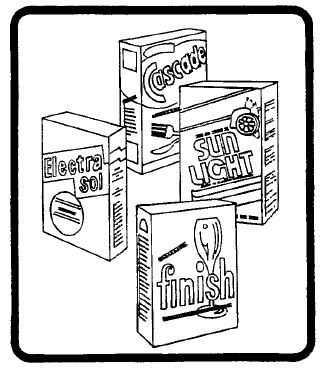
- Dishwasher detergents contain ingredients to clean dishes, protect metal and china, soften hard water, and prevent foaming and oversudsing. Using other types of detergents and/or soaps will block the wash action and cause water to overflow onto the kitchen floor.
- Use only fresh detergent. Old detergent that has caked will not dissolve properly. For best results, buy only one box of dishwasher detergent at a time. Store detergent in a cool dry location. Sealed boxes of detergent have a shelf life of 8 months; open boxes have 2 months.
Low Phosphate Detergents
- In some areas, the phosphate content of dishwasher detergents is limited by law. Therefore low phosphate detergents (8.7%) may be the only detergents available. The phosphate content is stated on the box.
- Unfortunately, these products are not as effective as those with higher phosphate levels. In order to obtain good washability, it may be necessary to use more detergent if the water supply is hard or moderately hard.
- It is possible that spotting or filming on glassware may occur when using a low-phosphate detergent.
How many detergents
- Experiment with different dishwasher detergents to see which one works best for you. The amount of detergent to use depends on the size of the load, the amount of soil, whether the soil has been allowed to dry or harden on the dishes, and the water hardness. Usually, a full mixed load of dishes and moderate water hardness will require 2-3 tablespoons of detergent per detergent cup. More detergent is required if the water is extremely hard.
- Using too much detergent in soft water or softened hard water can cause an etched film on glassware. This film, called silica film, cannot be removed. An early warning of this condition is the appearance of an iridescent effect on glasses. To prevent this from happening, check the water softness with the water company, be sure the water pressure supplied to the dishwasher is adequate, use less detergent (use at least 2 tablespoons per cup), and do not overload the dishwasher.
Detergent Chart
Grains per gallon as calcium carbonate is the common unit used for expressing the concentration of minerals dissolved in water. Water hardness is caused by calcium and magnesium in the water supply. High concentrations of these minerals and heat can form limescale. H you do not know the hardness of your water, contact the local water company.
Remove Film Deposits
If di1hes or glasses develop spotting or a white hazy film, they may be cleaned by one of the following methods:
- Commercial product method:
- Use Glass Magic® or some other commercial film and spot remover. Glass Magic® can be used safely any number of times and is made to be used in a normal dishwashing cycle. Follow package instructions.
- Chlorine bleach and vinegar method:
- Set the dishwasher for HEAVY SOIL and allow the dishwasher to fill, drain and refill.
- After the second fill, stop the dishwasher, open the door, and add 1 cup of liquid chlorine bleach to the wash water. Close the door and allow the dishwasher to complete the wash cycle.
- Allow the dishwasher to fill for the rinse cycle, then stop the dishwasher, and open the door. Add 2 cups of vinegar to the rinse water.
- Close the door and allow the dishwasher to complete the remaining rinse and dry cycles.
CAUTION: Do not place aluminum pots or pans, plasticware, metal items, or any detergent in the dishwasher when performing this cleansing process.
To remove a heavy film on items or a buildup of film on the dishwasher interior, acid treatment may be required. Follow the steps below using citric acid crystals which may be purchased at most drug stores.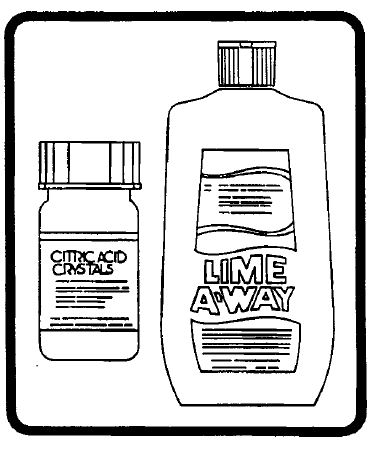
- Citric acid method:
- Run the soiled dish load through its normal cycle using detergent.
- Remove metal items from the dishwasher.
- Set the dishwasher for HEAVY SOIL. Do not add detergent.
- Allow the dishwasher to fill, then stop the dishwasher, open the door, and add 1/4 to 1/2 cup of citric acid crystals to the wash water.
- Close the door and allow the dishwasher to complete the cycle.
- Limeaway® method:
- Limeaway® is a liquid product designed to remove a limescale buildup or iron from the inside of the dishwasher. It is safe to use periodically according to package directions.
Rinse Aids
- Rinse aids help promote faster, spot-free drying. Rinse aids cause water to “sheet” or run off the dishes. “Sheeting” prevents water droplets from forming on the drying surface. Rinse aids are available in liquid and solid forms.
- The rinse aid dispenser is located inside the dishwasher door. The dispenser automatically dispenses a measured amount of the rinse aid into the dishwasher during the last rinse.
- Before using the dishwasher for the first time, unscrew the dispenser cap and add the sample bottle of Jet Dry-the rinse aid supplied with the dishwasher.
- Rinse aids may be purchased in most supermarkets, or from soap product distributors such as Amway.
- For best results, refill the rinse aid reservoir each month
How To Load
- Be sure all packing materials have been removed from the dishwasher interior.
- The wash arm should spin freely.
- Load the dishwasher properly, as described below, to use its full capacity and obtain the best dishwashing results.
Dishes do not need to be pre-rinsed before loading in the dishwasher. - Simply scrape away excess food, bones, pits, etc. Burned foods should be loosened before loading. Empty liquids from glasses and cups.
- If the dishwasher drains into a food disposer, be sure the disposer is completely empty before the dishwasher is started.
- For best results, the wash water must reach all soiled surfaces. Place items on the racks so they face toward the water source.
- Be sure large items do not block the detergent dispenser, preventing it from opening during the wash cycle.
- If you are not sure if an item is dishwasher safe, check the care instructions for the item or refer to the “Dishwashing Suggestions Chart.”
Loading The Bottom Rack
- Move the latch lever all the way to the left. Open the door all the way to the level position. Roll the bottom rack out onto the door. Load large items and silverware in the bottom rack.
- Large plates and platters-Slide between the pins with soiled surfaces facing the wash tower.
Bowls, casseroles, and sauce pans-Load upside down or at an angle facing the wash tower. Extra wide spaces for casserole dishes or baking pans are provided on either side and rear of the lower rack.
The arched pins will also allow plates and platters to be placed there when that space is not needed for larger bakeware. When items are tilted, better drainage is possible and water is less likely to collect on the bottom surfaces.
Silverware-The removable basket has sections for random placement of silverware. Load knives and forks with handles up. Mix spoons, forks, and knives to prevent “nesting.” Nesting causes improper circulation of wash and rinses water and prevents air circulation during the drying portion of the cycle.
Pots and pans-Place upside down and at an angle. Do not block the water action from the power turret. Do not allow handles to protrude through the bottom of the rack, blocking washer arm action. Do not block the flow of water to the detergent cups. Cookie sheets and other tall items can be placed along the hand side of the lower rack, below the raised step in the upper rack.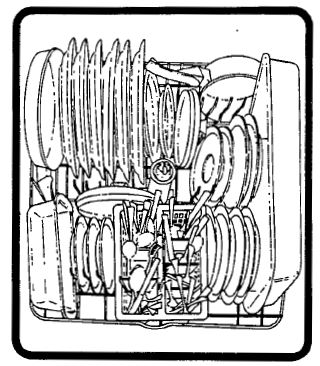
Top Rack Loading
- Pull the top rack all the way out to make loading easier. Small plates and saucers-Slide dishes between pins with soiled surfaces facing the center of the rack.
- Bowls-Place bowls upside down or slightly tilted toward the power turret, or place them between pins facing the center of the rack.
- Miscellaneous items-Lay long handled utensils and long lives on the top rack.
- Glasses and cups-Place glasses and cups against the outside pins, at an angle. Fit them securely between pins.
- The top outside prongs is extended in order to accommodate a second layer of cups or small glasses. Using the side prongs, place the cup edge over the outside of a single pin and inside the two pins on either side.
- Alternate the cups with the layer below, making sure that wash water can reach all inside surfaces. Make sure the second level of cups is not too tall for the rack to slide back into the dishwasher.
- After loading, slowly slide the top rack all the way back into the dishwasher.

- After loading, slowly slide the top rack all the way back into the dishwasher.
Adding Detergent
- Before adding detergent, check the detergent cups in the door to be sure water has not collected in the cups. If there is water in the cups, wipe them dry before filling them with detergent.
- Do not add detergent until you are ready to operate the dishwasher since detergents lose some of their effectiveness when exposed to moisture.
- NEVER USE SOAP, LAUNDRY DETERGENT, OR HAND
- WASHING DETERGENTS IN AN AUTOMATIC DISHWASHER.
- Such detergents or soaps cause oversudsing and may block wash action or cause water to overflow.
Adding/Removing Dishes
If you find that you have forgotten an item, or if you wish to remove items from the dishwasher after the wash cycle has begun, simply release the door latch, wait a few seconds until all action stops, and slowly open the door. Add or remove dishes and close the door. DO NOT LOCK. Wait a few seconds, then lock the door. This allows cold air to expand slowly inside the dishwasher and prevents water from overflowing as the door is shut
- Load the dishwasher according to directions.
- Fill appropriate detergent cups; close the detergent dispenser.
- Close the door, and move the latch all the way to the right to the lock position.
- Select the wash or rinse cycle; depress corresponding pushbuttons. See descriptions of wash and rinse cycles that follow.
- Select the HEATED DRY option; OFF for energy·saving air dry, ON for heated drying period.
- Tum the timer knob in a clockwise direction to the selected cycle. The knob will click into position at the beginning of each cycle selection.
- Connect the portable dishwasher. Follow these steps:
- Pull the power cord from the compartment at the rear center of the dishwasher. Plug it into a properly grounded electrical outlet.
- Run the hot water faucet to clear the water pipe of cool water. Turn the water faucet off.
- Attach the water hose to the faucet. Push down on the collar. When the coupler is in place on the faucet, release the collar. Check to make sure it is securely attached by pulling downward on the coupler.
- Turn on the hot water.
- To begin the dishwashing cycle, push the timer knob in. It will pop out automatically at the end of the dishwashing cycle.
NOTE: Water may be drawn from the bottom of the coupler while the dishwasher is operating by pushing on the red button on the side of the coupler. Direct water over the sink drain to pre - To disconnect the portable dishwasher:
- Turn off the hot water faucet and release pressure in the hose by pressing the red button on the side of the coupler.
- Push down on the collar of the coupler to disconnect it from the faucet and drain any water from the coupler.
- Return the hose and the power cord to the storage compartment at the rear. of the dishwasher for safe, convenient storage.
NOTE: Slight pauses during the operation of the dishwasher cycles are normal.
Dishwashing Cycle Selections
- Select the appropriate wash cycle from the descriptions below. If you are unsure about which cycle to use, check the “Dishwashing Suggestions” chart for the proper dishwashing procedures and cycles.
- Rinse & Hold-No detergent is used.
- Use the rinse & hold cycle when holding dishes for a period of time before running a regular wash cycle. It is good to use this cycle when waiting to accumulate a full load of dishes.
- Rinse & hold will rinse dishes for 10 minutes, then automatically advance to OFF.
- Short Wash-Add detergent to cup “2” only.
- Use Short wash for lightly soiled dishes and silverware. This cycle provides a 15-minute wash cycle, two rinses, and a drying period. Normal Soil-Add detergent to cups “1” and “2.”
- Use normal soil for regularly soiled dishes and silverware. This cycle provides a pre-rinse, wash, two rinses, and a drying period. If desired, detergent added to cup “3” will be released during the pre-rinse for a pre-wash.
- Heavy Soil-Add detergent to cups “l” and “2.”
- Use heavy soil for heavily soiled dishes, silverware, cookware, and other items which might require a double wash.
- This cycle provides a pre-rinse, two washes, two rinses, and a drying period.
- If desired, detergent added to cup “3” will be released during the pre-rinse for a pre-wash.
- Pots & Pans-add detergent to cups “l,” “2” and “3.”
- Use pots & pans for sticky pots, greasy broiler pans, encrusted casseroles or dishwasher-safe dinnerware. Scrape off excess food and load dishes so that water from the power turret and lower wash arm hit directly on the soiled side of the dishes. This cycle provides a wash, rinse, second wash, third wash, two more rinses and a drying period.
Warranty
Your Frigidaire Dishwasher is protected by this warranty
RJLL ONE-YEAR WARRANTY (Excluding Alaska)
Frigidaire CollY,)any warrants that Frigidaire will repair, without charge, any defect or malfunction occurring in this ~r during the first year after original date of delivery to the consumer.
LIMITED SECOND-YEAR WARRANTY (Excluding Alaska)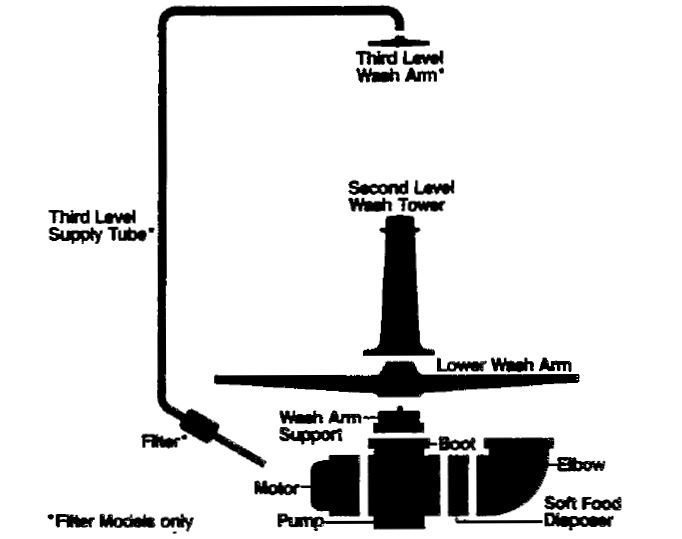
For the second year from the date of original installation, Frigidaire will provide, free of charge, replacement parts for any part of the “water Distribution System” (as illustrated) that fails because of a manufacturing defect. This Limited Second-Year warranty covers the motor, pump, lower wash arm, wash tower, wash arm support, boot, and soft food disposer on all models plus the upper spray arm and filter assembly on models including these features. Associated inlet and drain plumbing parts are not covered by this warranty. The consumer-owner will be responsible for all costs for labor and transportation.
LIMITED SECOND THROUGH TENTH-YEAR WARRANTY
(Excluding Alaska)
For the second through the tenth year from the date of installation, if the tub or door liner fail to contain water due to a manufacturing defect in the tub or door liner, Frigidaire will replace the tub or door liner at no cost for the parts. The consumer-owner will be responsible for all costs for labor and transportation.
LIMITED WARRANTY
(Applicable to the state of Alaska)
- In the state of Alaska, all of the provisions of the full or limited warranties and the exclusions thereunder listed on this form are unchanged except that Frigidaire does not pay for the cost of the technician’s travel to your home nor for the cost of transporting the product to his shop. You are responsible for these charges.
- This warranty gives you specific legal rights, and you may also have other rights which vary from state to state.
- This is the only written warranty applicable to Frigidaire Dishwashers and Frigidaire neither assumes nor authorizes anyone to assume for it any other obligation or liability in connection with such Dishwashers.
- FRIGIDAIR~ SHALL NOT BE LIABLE FOR CONSEQUENTIAL DAMAGES SUCH AS PROPERTY DAMAGE AND INCIDENTAL EXPENSES RESULTING FROM A BREACH OF THIS WRITTEN WARRANTY OR ANY IMPLIED WARRANTY.
- Some states do not allow the exclusion or limitation of incidental or consequential damages so this limitation or exclusion may not apply to you.
FOR SERVICE UNDER THIS WARRANTY contact any authorized frigidaire servicing dealer, or, if there is a question as to where to obtain warranty service, write our Customer Relations Department at this address.
FRIGIDAIRE APPLIANCE COMPANY 300 Phillipi Road Columbus, Ohio 43228
THIS WARRANTY DOES NOT APPlY:
- To conditions resulting from (A) improper installation, or (B) incorrect electric current.
- To conditions resulting from consumer damage, such as: (A) improper maintenance, or (B) misuse, abuse, accident, or alteration.
- If the original serial number cannot be readily determined.
- To service calls do not involve malfunction or defects in materials or wor1<manship, and naturally, the consumer shall pay for such calls.
- Dishwashers installed outside the continental United States and Hawaii.
- If used in any commercial application.
FRIGIDAIRE APPLIANCE COMPANY
A Division of White Consolidated Industries, Inc.
FAQs About Frigidaire DW3300D Dishwasher
How long does a dishwasher like the Frigidaire DW3300D run?
The Normal Cycle usually lasts 60 to 80 minutes. Was this article of use to you?
How long is the warranty on a Frigidaire dishwasher?
In general, Frigidaire offers one-year warranties on its products. These warranties, which cover both parts and labor, are in force at the time of purchase. Contacting the company’s support line is all you need to do if a problem arises with your Frigidaire appliance during the first year of use.
How long does it take the dishwasher from Frigidaire to dry?
The Light, Normal, and Heavy cycles of the FGHD2472PF each require about two hours.
Dishwashers from Frigidaire do they have issues?
Additionally, hundreds of customers assert that Frigidaire dishwasher control panels, motherboards, and circuit boards frequently malfunction soon after the warranty has ended or that Frigidaire dishwashers leak near the motor, which likewise malfunctions and results in damage.
Why starts and stop my Frigidaire DW3300D dishwasher?
The likelihood is that the door latch is loose if your dishwasher continuously beeps and stops. The sensor on the door latch is shorted out or covered up, which is the cause of the dishwasher stopping mid-cycle. Additionally, the door latch may just be damaged.
The water in the Frigidaire DW3300D dishwasher is heated.
When the HI-TEMP WASH option is used, the dishwasher raises the temperature of the water in the primary wash to roughly 140°F (60°C). Dishwasher detergent works more efficiently to remove food fat and soil from dishes with the help of the hotter water, which also speeds up drying.
The water in the Frigidaire DW3300D dishwasher is heated.
When the HI-TEMP WASH option is used, the dishwasher raises the temperature of the water in the primary wash to roughly 140°F (60°C). Dishwasher detergent works more efficiently to remove food fat and soil from dishes with the help of the hotter water, which also speeds up drying.
Does a Frigidaire DW3300D dishwasher have fuses?
By turning off your dishwasher when it becomes too hot, the thermal fuse protects it. The issue is that the fuse may occasionally blow, preventing you from turning your dishwasher back on. The thermal fuse can be tested as follows: Ensure that the dishwasher’s electricity is still off.
Do dishwashers like the Frigidaire DW3300D require an air gap?
Either an air gap or a drain pipe with a high loop are necessary for dishwashers. These features are in charge of preventing dishwasher effluent from entering the dishwasher. Typically, the air gap is a fitting attached to the kitchen cabinet or sink.
For more manuals by Frigidaire, visit ManualsDock

